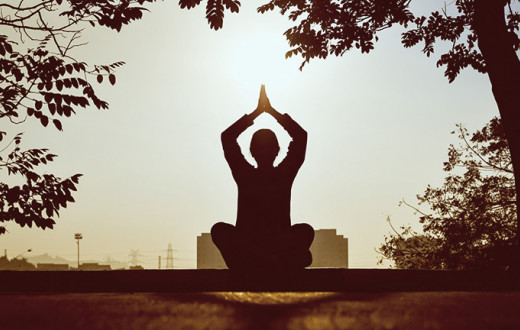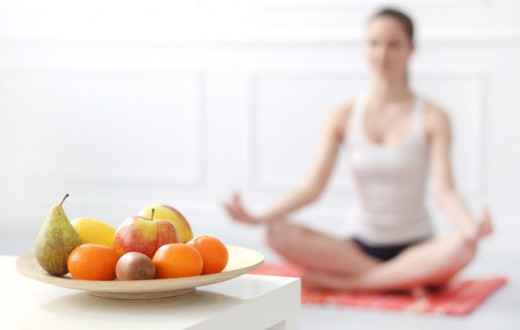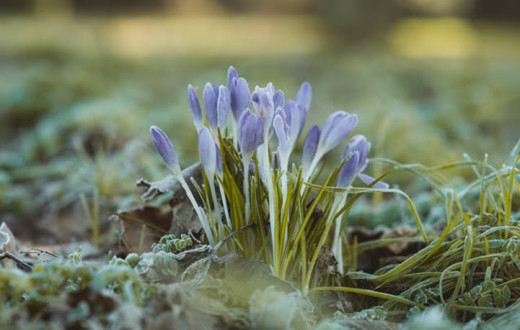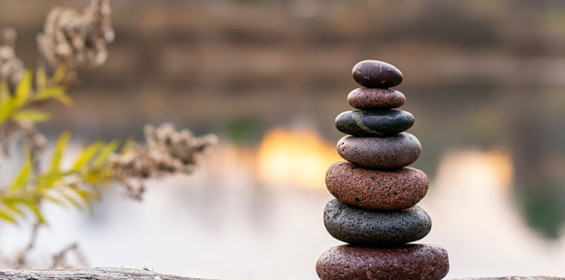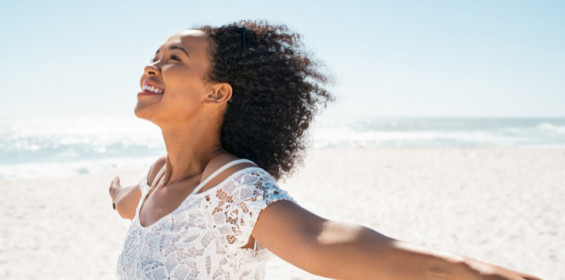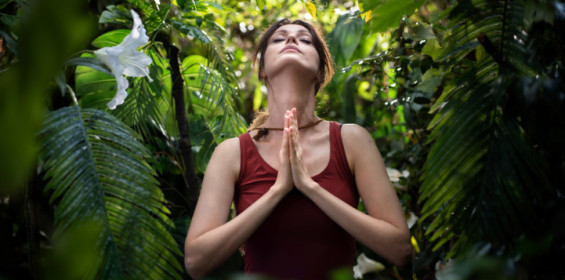By Sejal Shah | Posted: November 11, 2019
There are some days when you just dread getting up in the morning and having to face the world. Hopelessness takes over, and you may feel helpless and anxious. If this happens often, chances are that depression is knocking at your door, and it might be time to seek help.
According to Newsweek, “In the U.S., nearly 1 in 5, or roughly 43 million Americans, suffer from a mental illness, including conditions like depression, anxiety, or schizophrenia. These individuals often experience difficulty getting the health care that they need, and available medications don't always provide satisfactory effects. For this and other reasons, many individuals coping with mental health issues seek alternative approaches to healing, including yoga.”
According to U.S.News, treating depression can be complicated, and may involve a whole lot of trial and error with different medications, types of therapy, and lifestyle changes. But one relatively straightforward and basically side effect-free management option is yoga, which recent research has shown can improve mood and anxiety measures in people with depression so significantly that they match those of non-depressed individuals.
Research has revealed that yoga increases the levels of the neurotransmitter GABA. People who are struggling with anxiety and depression typically have low GABA levels. This makes yoga incredibly relevant to its use in the treatment of mental health conditions.
On the other hand, regular yoga practice and therapy helps to reduce stress levels and promote relaxation. The high levels of stress that accompany our busy modern lifestyles can result in emotional and physical health issues. Prolonged stress can have a negative impact on your mental health, which means that implementing a regular practice that reduces stress has far-reaching benefits. There’s nothing like the serenity, bliss, and relaxation that can come following a good yoga therapy session. In fact, many first-time yoga practitioners are surprised by how elevated their mood becomes after just one yoga class.
Yoga isn’t like other forms of exercise. In fact, it takes a unique, relaxed approach to fitness that comes as a refreshing contrast to many upbeat, intense, and modern workout classes. As such, yoga not only gets our blood pumping to elevate our mood; it also simultaneously soothes us into a state of relaxation through meditation and breathing techniques. This approach makes yoga an excellent option for those with anxiety and depression.
Although there are hundreds of yoga poses, some are particularly good for dealing with anxiety and depression. Here, we will discuss some postures that you can incorporate into your own practice to invite greater mental health into your life.
As you practice these, be sure to breathe evenly, steadily, and deeply, without straining your body. You can either breath normally or use ujjayi breath throughout your practice. Doing this will help you remain calm in states of adversity, a skill that can help you stay grounded in many of life’s challenging moments!
1. Easy Pose (Sukhasana)
Easy pose is the classic position that you see people meditating in, sitting on the floor with crossed legs and a straight spine. Although many might not think of it as a yoga pose, easy pose can actually be a powerful tool for regaining the confidence you need to deal with anxiety, depression, and chronic stress.
In Easy Pose, the base of your spine connects to the earth, helping you feel deeply grounded. The symmetry of this posture also centers you. These two factors combined aid you in overcoming anxiety as you feel that nothing can uproot you or knock you off balance.
Furthermore, this pose helps to ward off depression as well. Sitting tall in perfect posture with easy, even, and smooth breathing, you can experience a sense of clarity, confidence, and strength.
Here’s how to do easy pose:
- Sit on the floor or a yoga mat with your legs crossed.
- Use a cushion or blanket to elevate your hips so that your knees are pointing downwards.
- Align your torso with your hips, keeping your spine straight and firm yet relaxed. If you like, you may also use some kind of back support like a wall or meditation chair.
- Lengthen your tailbone.
- Keep your shoulders and neck relaxed.
- Focus your attention on your heart. Keep your left palm on your heart and right palm on your navel. Close your eyes and take some deep, relaxed breaths. Feel the breath moving in your belly and chest area like a wave rising and falling.
- Remain here for as long as you’d like and you are comfortable.
As you sit in easy pose, you can recite a mantra or watch your breath. Both of these are great methods for keeping your mind focused.
To learn more about the pose, click here: Easy Pose
2. Child’s Pose (Shishuasana or Balasana)
Child’s pose is among yoga’s most restorative and comforting postures. In Child’s Pose, you enjoy the immense comfort that comes with being totally grounded. The sense of being supported by the earth can provide great emotional comfort in times of anxiety and depression.
In addition to being comforting, child’s pose also works to release tension in the spine, thus calming your nerves.
To perform child’s pose, follow these steps:
- Kneel on your mat, and sit on your heels with your big toes touching and your knees slightly wider than your hips.
- Bend forward, stretching your arms and chest forward.
- Rest your head on your mat or a blanket with your arms stretched forward on either side of your head, palms resting on the mat.
- Breathe deeply and relax here for as long as you’d like before gently sitting back up.
To know more about the pose, click here: Child’s Pose
3. Downward Facing Dog Pose (Adho Mukha Svanasana)
If you’ve explored yoga at all, you’re probably familiar with Downward-Facing Dog pose. There’s a good reason that this posture is quite popular in the yoga community: in addition to lengthening your spine and strengthening your arms, shoulders, and legs, it also increases blood flow to your brain. By amping up our circulation to this area, we can experience greater energy and mental clarity, helping us deal with issues that cause us stress or anxiety.
For Downward-Facing Dog pose, follow these steps:
- Come to all four on your hands and knees with a flat back.
- Lift your hips up by pushing against the ground with your toes.
- Straighten your legs and arms.
- Push against the ground with your hands to all your hips to rise up.
- Your body should come to an inverted v-shape.
- If you feel tightness in your legs, it’s OK to bend your knees.
- After taking a few breaths here, gently release the pose.
To learn more about this pose, click here: Downward Facing Dog Pose
4. Upward-Facing Dog Pose (Ūrdhva Mukha Svānāsana)
Another excellent pose for handling mild anxiety and depression is Upward-Facing Dog pose. This position opens your heart, helping you remove any pent-up emotions in your chest. It also works to regulate the respiratory system, bringing clarity to your heart and mind. It has an overall rejuvenating effect on your body, and all the stress trapped in your back will disappear.
For Upward Facing Dog pose, follow these steps:
- From Downward Facing Dog, push into your palms to elevate your upper body, smoothly curving the spine.
- Keep your knees off the mat and both legs fully stretched and straight.
- Lift your chest and head facing forward while keeping your shoulders broad.
- Lengthen your upper body in a nice curve and legs in a straight line.
- Take a few deep breaths here before gently releasing the posture.
To learn more about this pose, click here: Upward-Facing Dog Pose
5. Standing Forward Fold Pose (Uttanasana)
You’re probably familiar with Standing Forward Fold pose even if you don’t realize it. Another good way to describe it is simply touching your toes. This pose works wonders for removing tension in the neck, shoulders, and back, while also directing blood flow to your brain. All in all, regularly practicing Standing Forward Fold pose can make you feel great.
Here’s how to do it:
- Stand up straight with your hands by your side.
- Place your hands by your hips and slightly bend your knees as you bend forward.
- Your chest should touch your thighs; if it doesn’t, try bending your knees further.
- Take your hands down and grab your ankles.
- Remain here for a few breaths before gently standing back up.
To learn more about this pose, click here: Standing Forward Fold Pose
6. Bridge Pose (Setubandhasana)
One of my favorite poses, Bridge Pose, calms the brain and helps alleviate stress and mild depression and reduces anxiety, fatigue, backache, headache, and insomnia as well.
Here’s how to do it:
- To begin, lie on your back.
- Bend your knees so that your feet are flat on the floor in a parallel position in line with your sitting bones, about a foot’s distance away from your hips.
- Place your arms by your sides with your palms facing down.
- As you inhale, begin to roll your spine upward as you lift your hips toward the sky. You will feel the lower, middle, and upper back sequentially peel off the mat. Support the weight of your body through your feet, ankles, and thighs rooting down into the ground.
- Squeeze your buttocks to keep a lift through your hips and keep your legs in a parallel position without collapsing or splaying outward.
- Maintain an easy breath as you strengthen your body in this pose.
- Hold the posture for 1-2 minutes and then release on an exhalation.
To learn more about this pose, click here: Bridge Pose
7. Corpse Pose (Savasana)
Don’t let the name fool you! Corpse pose is actually one of the most gentle, easy, and comforting postures that yoga has to offer. This pose is excellent for relaxing your mind, freeing you from stress, anxiety, and depression while inviting clarity into your experience.
Although the physical side of Corpse Pose is quite easy, mastering the mental aspect of this pose can be a challenge. However, with easy, smooth, and even breaths, you’ll ultimately unlock deep states of calmness and bliss.
This pose is typically performed at the end of each yoga session, allowing you to integrate all the energy and revelations that may have been cultivated during your practice.
To perform corpse pose, follow these steps:
- Lie flat on your back on your mat.
- Rest your arms with palms facing up on the ground a few inches away from your body.
- Legs should be comfortably apart with your knees slightly spread and your toes pointing outwards.
- Close your eyes, take your awareness to different parts of the body, and consciously relax every part of your body, including your toes, ankles, shins, calves, left knee, right knee, and so on, until you’ve relaxed each body part. Alternatively, you could also use this guided yoga nidra meditation and slip into deep relaxation.
- After you’re fully relaxed, keep breathing slowly and deeply from your belly.
- Remain here for as long as you’d like.
- When you’re finished, gently roll onto your right side for a moment before getting up.
To learn more about this pose, click here: Corpse Pose
In addition to these yoga poses, breathing practices like Sudarshan Kriya and Sahaj Samadhi meditation are proven by various scientific studies to be of immense help in alleviating anxiety and depression.
If you struggle with mental health issues, we recommend finding the yoga studio that is best for you and attending as often as possible. Not only will yoga make you feel great, but the sense of community that studios cultivate can give you the social support you need to feel better.
Yoga offers support, strength, and the ability to live in the moment. The unique mind-body approach of yoga is more and more becoming a popular choice for fighting depression. It’s holistic and long-lasting without any side effects. So, why not give it a try?
Sejal Shah, E-YRT 500 Sri Sri Yoga Teacher, YACEP, Meditation Teacher, Happiness expert, NYU Post Graduate Medical School approved Yoga-CME retreat facilitator, Mind-Body Wellness Writer, Homeopath. She can be followed on Instagram, Twitter, and Facebook.







